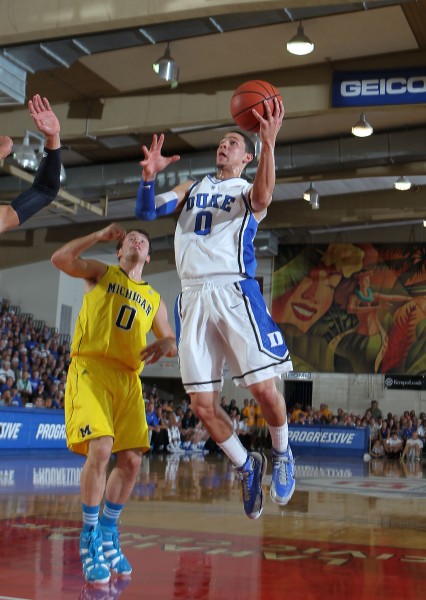Night Line: Duke Resembling Its 2010 Championship Team?
Posted by EJacoby on November 25th, 2011Evan Jacoby is an RTC columnist. You can find him @evanJacoby on Twitter. Night Line will run on weeknights during the season, highlighting a major storyline development from that day’s slate of games.
The Maui Invitational finals played to an instant classic last night, with Duke leaving the island as champions yet again. Coach K and the Blue Devils are now a perfect 15-0 in their five trips to Maui. Duke has won the first seven games of this season, and a team that nearly lost its season-opener at home to Belmont is starting to establish an identity. Upon further review, the 2011-’12 Blue Devils might just begin to resemble the 2009-’10 team that cut down the nets as NCAA Tournament champions. Just to be clear — no, this is not to say that Duke is the title favorite this season — teams like Ohio State, Kentucky, North Carolina, and UConn may be better built for long-term success. But the 2010 Blue Devils were a surprise champion, and this Duke team has a similar make-up.
Duke started five upperclassmen (Smith, Scheyer, Singler, Thomas, Zoubek) in 2010 and turned to their bench for youth and energy. This year’s team starts four upperclassmen (Curry, Dawkins, Kelly, Mason Plumlee) and brings sophomore Tyler Thornton and freshman Quinn Cook off the bench, along with senior Miles Plumlee, to provide a spark. The biggest difference here is that freshman Austin Rivers is starting on the wing where the 2010 team had a junior leader, Kyle Singler, filling that role. But Rivers (14.4 PPG) is so far having a similar scoring impact on the game that Singler (17.7 PPG) did, and the rookie will no doubt continue to improve as the season goes along. While this year’s backcourt of Seth Curry and Andre Dawkins are not the big-name stars or volume scorers that Nolan Smith and Jon Scheyer were, the two have seen tremendous improvements from last season and are playing at a very high level. This year’s team makes up for the small backcourt-scoring gap with Mason Plumlee’s offensive contributions down low. Plumlee averages 11.4 points per game so far, while no inside player averaged more than 5.6 PPG for the champions.
The national champion Blue Devils were a tremendous three-point shooting team, finishing the year hitting 38.5% from deep that ranked 26th in the nation. They scored 1.16 points per possession, the fourth highest number in all of Division I that season. This year, Duke is off to another scorching start from deep, hitting an insane 45.9% of its threes, and overall the team scores 1.13 points per possession. Smith, Scheyer, and Singler all shot at least 38% from long range and averaged over 17 points per game. This year, Curry, Dawkins, Rivers, and Ryan Kelly are all shooting at least 38% from deep, and each scores at least 10 points per game. The perimeter shooting contributions are similar in impact.
The 2010 team began that season ranked number nine in the preseason AP Top 25, and was not a preseason title favorite. This year has a similar setup, with Duke starting the year ranked number six in the polls. The significant improvements of Curry and Dawkins is at least bringing back memories of the Smith-Scheyer championship backcourt. If Rivers can continue to improve as an impact player and Mason Plumlee continues his consistent double-double production, then there are enough offensive weapons on this team to make a deep run. Not to be forgotten, the bench has been providing great contributions, highlighted by Tyler Thornton’s effort last night when he hit the two biggest shots of the game (and his career). A young Dawkins and Mason Plumlee provided that kind of spark in 2010 for the champions.
Perhaps the biggest difference between these two teams right now is rebounding. The 2010 team had an offensive rebound percentage of 40.6% that was sixth-best in the country. This year’s team is grabbing just 29.2% of all available offensive boards, a disappointing 267th best. The big bodies of Brian Zoubek, Lance Thomas, and a rookie Mason Plumlee in 2010 gobbled up offensive boards, part of the puzzle that led to so many subsequent three-point makes. As Jay Bilas constantly points out during ESPN telecasts, there is no better time to shoot the three than after an offensive rebound before the defense has recovered. This year’s team has not had the luxury of nearly as many second-chance open threes.
If the Blue Devils continue their strong defense, where opponents are scoring just 0.96 points per possession (compared to 0.92 PPP in 2010), then they just might have enough of a three-point shooting advantage and ability to score in bunches that can lead them to beat nearly any opponent. The 2010 team rode this formula to a National Championship, and Coach K’s team this year is already proving that it’s extremely tough to beat in the clutch. Next up on Duke’s grueling schedule is one of the aforementioned power teams — Ohio State on Nov. 29 — and though that will be a true test of this team’s current winning formula, it shouldn’t discount the likelihood that Duke could once again with the right matchups in March be standing on top of the podium holding its fifth national championship trophy.












































